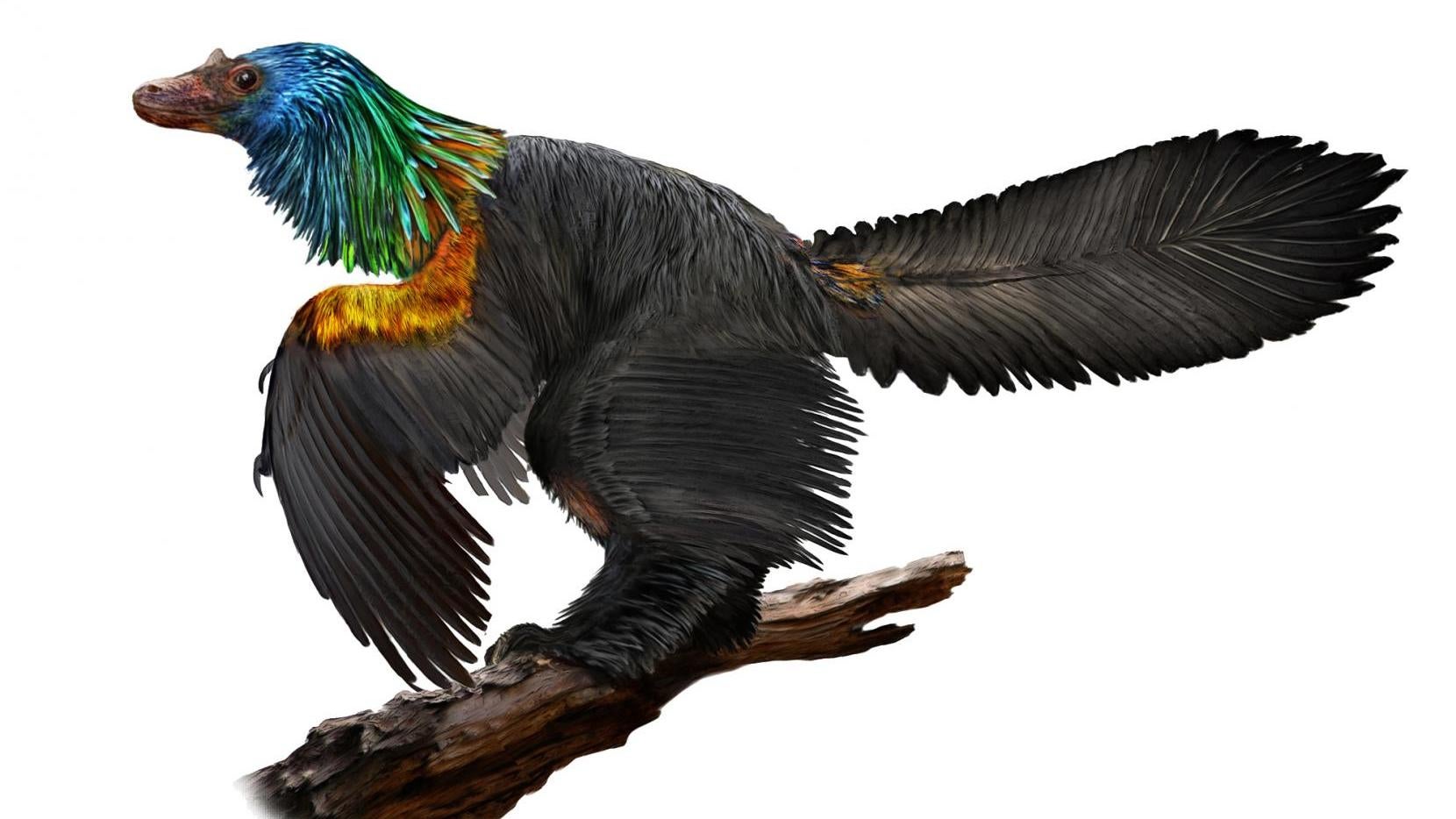Science
Related: About this forumThis Bird-Like Dinosaur Featured a Stunning Rainbow-Colored Mane
Source: Gizmodo
This Bird-Like Dinosaur Featured a Stunning Rainbow-Colored Mane
George Dvorsky
Today 3:00pmFiled to: DINOSAURS
Introducing Caihong juji, a tiny, Jurassic-era dinosaur that lived 161 million years ago in what is now China. The feathered theropod featured an iridescent, rainbow colored ring of feathers around its neck, which scientists believe it used to attract mates.
A nearly complete skeleton of Caihong juji—a name that means “rainbow with the big crest” in Mandarin—was discovered by a farmer in China’s Hebei Province in 2014. Researchers from the University of Texas at Austin and Shenyang Normal University have been taking a close look at it, releasing their findings today in Nature Communications. Paleontologist Dongyu Hu, the lead author of the new study, says the newly discovered dinosaur contained a curious mix of ancient and modern features, including iridescent plumage seen in some living birds.
This distinctly bird-like creature belonged to a group of dinosaurs known as the Yaniliao theropods, a suborder known for their hollow bones and three-toed limbs. Using a focused ion beam-scanning electron microscope, the researchers analyzed the impressions on the fossil left by C. juji’s feathers. The plumage on its neck contain what appears to be traces of melanosomes—wide, pigment-containing packets that give feathers their color. A comparative analysis of these melanosomes resulted in a close match with the iridescent, rainbow-patterned feathers found in hummingbirds. The researchers speculate that this was an ornamental display used to attract mates.
“Iridescent coloration is well known to be linked to sexual selection and signaling, and we report its earliest evidence in dinosaurs,” said study co-author Julia Clarke, a professor in the Department of Geological Sciences at the UT Jackson School of Geosciences, in a statement. “The dinosaur may have a cute nickname in English, Rainbow, but it has serious scientific implications.”
-snip-
Read more: https://gizmodo.com/this-bird-like-dinosaur-featured-a-stunning-rainbow-col-1822093711

Illustration by Velizar Simeonovski, The Field Museum, for UT Austin Jackson School of Geosciences.
______________________________________________________________________
Source: Nature Communications
A bony-crested Jurassic dinosaur with evidence of iridescent plumage highlights complexity in early paravian evolution
Dongyu Hu, Julia A. Clarke, Chad M. Eliason, Rui Qiu, Quanguo Li, Matthew D. Shawkey, Cuilin Zhao, Liliana D’Alba, Jinkai Jiang & Xing Xu
Nature Communications 9, Article number: 217 (2018)
doi:10.1038/s41467-017-02515-y PalaeontologyTaxonomy
Received: 17 February 2017
Accepted: 05 December 2017
Published online: 15 January 2018
Abstract
The Jurassic Yanliao theropods have offered rare glimpses of the early paravian evolution and particularly of bird origins, but, with the exception of the bizarre scansoriopterygids, they have shown similar skeletal and integumentary morphologies. Here we report a distinctive new Yanliao theropod species bearing prominent lacrimal crests, bony ornaments previously known from more basal theropods. It shows longer arm and leg feathers than Anchiornis and tail feathers with asymmetrical vanes forming a tail surface area even larger than that in Archaeopteryx. Nanostructures, interpreted as melanosomes, are morphologically similar to organized, platelet-shaped organelles that produce bright iridescent colours in extant birds. The new species indicates the presence of bony ornaments, feather colour and flight-related features consistent with proposed rapid character evolution and significant diversity in signalling and locomotor strategies near bird origins.
Introduction
Theropod dinosaurs from the Middle-Late Jurassic Yanliao Biota have been among the most significant discoveries informing the bird origins1,2,3,4,5,6,7,8. However, with the exception of the bizarre scansoriopterygids, these species have shown some marked skeletal similarities to the slightly younger ‘urvogel’ Archaeopteryx, for example, in skull shape and forelimb proportions4,5.
The newly discovered Yanliao specimen described here is another exception to the general pattern. This new theropod shows an array of bony features, as well as plumage characteristics and putative melanosome morphologies not previously seen in other Paraves, and thus further informs the pattern of character acquisition close to the origin of avian flight.
-snip-
Read more: https://www.nature.com/articles/s41467-017-02515-y
tblue37
(65,393 posts)Irish_Dem
(47,119 posts)left-of-center2012
(34,195 posts)hunter
(38,317 posts)As one might expect from the amazing diversity of colors and patterns exhibited by more than 10,000 bird species found in the world, birds can see color. The colors in the feathers of a bird are formed in two different ways, from either pigments or from light refraction caused by the structure of the feather. In some cases feather colors are the result of a combination of pigment and structural colors. The greens of some parrots are the result of yellow pigments overlying the blue-reflecting characteristic of the feathers.
--more--
https://academy.allaboutbirds.org/how-birds-make-colorful-feathers/
The feathers of this bird-like animal are preserved well enough to see similar colorization structures.
Victor_c3
(3,557 posts)It’s a long story, but I’m actually going back to college for the fun of it and I took a semester-long class that was a brief overview of prehistoric life. It’s amazing how much better of an understanding we have now than we did when I was in school as a kid in the 1980s and 1990s.
The world is/was much more interesting than I realized it was.